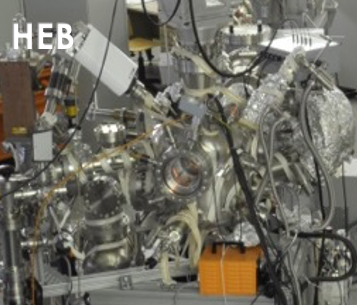Both beamlines are equipped with a main analysis chamber connected to a preparation chamber by means of a gate valve. The systems are equipped with a fast entry lock and a sample transfer mechanism which allow to insert the sample in UHV without breaking the vacuum. The main analysis chambers are equipped with an He cooled cryogenic manipulator at the end of which the sample is held. The sample temperature can be varied and PID stabilized in the 15-400 K range using a resistive heater controlled by a diode. Gas can be delivered through a leak valve on the substrate held at 15-18 K by a custom gas dosing tube connected to a gas line. Desorption studies as a function of temperature can be done by TPD (Temperature Programmed Desorption) measurements by using a quadrupole mass spectrometer, calibrated by adsorbing/desorbing known quantity of gas from flat surfaces.
In the HE system structural analysis are possible “in situ” by XPS measurements, performed by exposing the sample to the radiation delivered by a UV or an X-ray source and revealing the photoelectrons by means of a hemispherical electron analyzer. A LEED system is also available, both in HE and LE system. The two chambers are connected to the two bending magnet beamlines of DAFNE, covering the energy range from 35 eV to 1000 eV (LE) and 60-1000 eV (HE), thus allowing photon irradiation studies. The preparation chamber of both systems are equipped so as to perform sample sputtering. In the HE system, an evaporator for physical vapor deposition processes is mounted, thus allowing the preparation of substrates in controlled environmental conditions (without passing through ambient atmosphere).

A structural analysis by Raman spectroscopy can be performed “in situ” in the LE preparation chamber. The coupling by optical fiber of this chamber with a Raman microscope (foundamental at 532 nm) already present in the laboratory is in progress. The main chamber implementation with a new mass spectrometer having mass range up to 500 amu is going on. This indeed allows the identification of chemical products that cannot be observed with the mass spectrum already at the disposal of the experimental equipment (100 amu).

